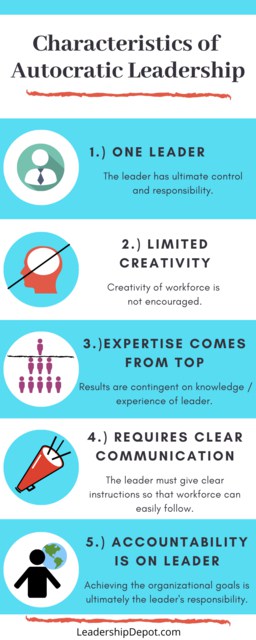To really get into what autocratic leadership looks like, it helps to first define autocratic.
If you look at the root of the word, “auto” comes from ancient Greece and means, of or relating to oneself. (1)

Autocratic leadership is a style of leading where decisions are made by the leader, without the input of others. It’s authoritarian in nature (which is why authoritarian leadership and autocratic leadership are synonymous. Have you ever heard of the authoritarian parenting style? It’s the type of parent who gives orders to their child without any discussion and without giving the child the ability to be involved in the process beyond carrying out what’s asked.)
An autocratic leader draws conclusions and makes strategic decisions about the direction of the organization based on his/her own
belief system with little or no advice from others.
Let’s take a look at the overall characteristics of autocratic leadership:

To further explain, Autocratic leaders are:
- ultimately in control.
- reliant solely on their beliefs and knowledge. This limits creativity in problem-solving because no other thoughts or ideas are generally considered.
- reliant on the capability of the leader (i.e., their competence and experience is key to success.)
- responsible for the clear communication of the goals and how they’ll be achieved.
- accountable for the overall attainment of the organizations’s goals.
So What are the Pros and Cons of Autocratic Leadership?
Pros:
- Decisions can be made quickly because only one person makes the decisions. Action can happen faster.
- Communication and efficiency can be improved. There’s one message from one individual instead of a generally understood
direction presented by different people with their own take who each may present the direction slightly differently. Because there’s no collaboration–which takes time– productivity can be improved. - There’s a clear chain of command. This can be beneficial where the workforce is inexperienced, and the leader is knowledgeable.
- Employees may have reduced stress because they’re not responsible for making decisions where the results are ambiguous. Because employees are only responsible for carrying out the directions of the leader, employees are responsible for their performance within the guidelines presented to them. Ultimately, the leader is responsible for the results and the success or failure of those results.
Cons:
- Work tends to be very structured and rigid.
- Creativity isn’t encouraged, and therefore, there’s no possibility that a better method or better results can be realized.
- The autocratic management style can lead to reduced productivity since every decision is reliant on the leader before action is taken.
- This style of management can lead to micromanagement. Since the leader is ultimately responsible for the decisions, employees are just tasked with carrying out duties, with no input, which can cause reduced employee morale. Employees can feel undervalued.
- Autocratic leadership can be difficult to sustain long-term since the employees associate the directives with the person in the leadership role; if a successor suddenly needs to take over, disruption can take place.
Can Autocratic Leadership Work?
Absolutely. While other styles that allow for more free-flowing thoughts that go back and forth between management and employees is often more advantageous, there are times when this style of leadership can work well.
Since this style of leadership is top-down in nature, autocratic leadership works best when the leader is extremely clear with directives. Additionally, since employees are expected to act in accordance with what the leader has outlined, recognition of those who perform as expected can help with morale where employees appreciate recognition.
Autocratic leadership can be effective when:
- an organization requires confidentiality at different levels (Employees at different levels don’t have all of the information in order to assess the entire picture.)
- the leader is highly knowledgeable and is considered more knowledgeable or experienced than the employee base.
- the leader is confident, and is also passionate about their objectives.
- safety is essential to realizing the organizational results.
Examples of Autocratic Leadership
- Governments run by dictators are examples of this style of leadership.
The leader of the Democratic People’s Republic of Korea , Kim Jong-un, can be considered to be an autocratic leader. His personality is described as dominant and controlling, outgoing, ambitious, confident, and dauntless. People in this type of position thrive on being in a position of power, enjoying directing others in a way that elicits respect and obedience. (2)
- Administration within the medical industry
Because of the laws surrounding the processing and ultimately, the confidentiality of patient medical records, this type of workplace can often be headed by an autocratic leader.
- Mining
This type of work environment, as well as other industries where safety of the employees is paramount, may often be autocratic in nature. Methods of work are dictated by the leadership and strict adherence to these methods are expected. Guidelines are clearly communicated and understood by the employees.
In summary, there are times when the autocratic style of leadership is the best style to use to meet objectives. There are other times when a different style might be more beneficial to meeting objectives and growing the company. If different styles of management are needed at different times within the same company, situational leadership might be the best choice.
Sources:
(1) Wiktionary

